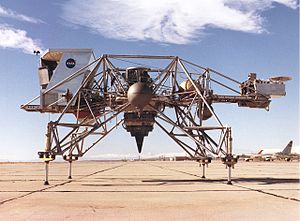LLRV
| Lunar Landing Research Vehicle (LLRV) Lunar Landing Training Vehicle (LLTV) |
|
|---|---|
 |
|
| The Lunar Landing Research Vehicle (LLRV) | |
| Role | Experimental VTOL aircraft |
| Manufacturer | Bell Aerosystems |
| First flight | 30 October 1964 |
| Primary user | NASA |
| Number built | 2 LLRVs 3 LLTVs |
| Unit cost |
$2.5 million
|
The Bell Aerosystems Lunar Landing Research Vehicle (LLRV) was an Apollo Project era program to build a simulator for the Moon landings. The LLRVs were used by the FRC, now known as the NASA Armstrong Flight Research Center, at Edwards Air Force Base, California, to study and analyze piloting techniques needed to fly and land the Apollo Lunar Module in the Moon's low gravity environment.
The research vehicles were vertical take-off vehicles that used a single jet engine mounted on a gimbal so that it always pointed vertically. It was adjusted to cancel 5/6 of the vehicle's weight, and the vehicle used hydrogen peroxide rockets which could fairly accurately simulate the behaviour of a lunar lander.
Success of the two LLRVs led to the building of three Lunar Landing Training Vehicles (LLTVs) an improved version of the LLRV, for use by Apollo astronauts at the Manned Spacecraft Center in Houston, Texas, predecessor of NASA's Johnson Space Center. One LLRV and two LLTVs were destroyed in crashes, but the rocket ejection seat system recovered the pilot safely in all cases.
The final phase of every Apollo landing was manually piloted by the mission commander. Because of landing site selection problems, Neil Armstrong, Apollo 11 commander, said his mission would not have been successful without extensive training on the LLTVs. Selection for LLTV training was preceded by helicopter training. In a 2009 interview, Apollo astronaut Curt Michel stated, ”For airborne craft, the helicopter was the closest in terms of characteristics to the lunar lander. So if you didn’t get helicopter training, you knew you weren’t going. That sort of gave it away.” Even Tom Stafford and Gene Cernan did not get LLTV training for their Apollo 10 mission which was the first flight of the Lunar Module to the Moon, because NASA "didn't have plans to land on Apollo 10" so "there wasn't any point in...training in the LLTV." Cernan only got this training after being assigned as backup commander for Apollo 14, and in 1972 was the last to fly the LLTV while training as commander for Apollo 17, the final landing mission.
...
Wikipedia
